Effective Solutions for Unclogging Toilets
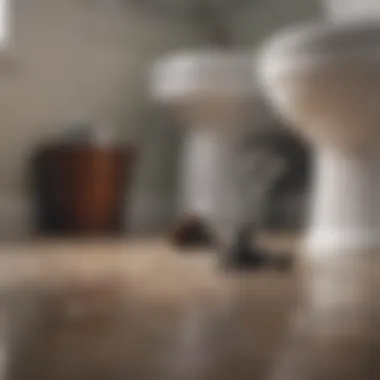

Intro
Clogged toilets can be a deeply frustrating issue for homeowners. They disrupt daily routines and can lead to serious problems if not addressed timely and effectively. Understanding how to unclog a toilet is essential knowledge that all homeowners should possess. This comprehensive guide delves into the numerous solutions available, while weighing their pros and cons, to ensure that individuals can make informed choices.
The Importance of Knowledge
When faced with a toilet clog, having the right tools and techniques at your disposal can save time and prevent costly damages. From traditional plungers to advanced chemical solutions, the options are varied and often dependent on the nature of the clog. It is crucial to assess the situation and determine the most suitable method for effective unclogging. Additionally, understanding the underlying causes of clogs can help in preventing future issues.
In this guide, we aim to equip readers with insights that can lead to efficient solutions, tailored to their specific circumstances. Through a detailed discussion on various unclogging methods, this guide provides the reader with a comprehensive understanding of each option.
Effective unclogging is not just about the immediate fix; it also involves preventive measures and knowledge about pipe maintenance. The following sections will explore the tools, techniques, and tips necessary for maintaining a functional restroom environment. With careful consideration and practice, homeowners can navigate the challenges of a clogged toilet with confidence.
Understanding Toilet Clogs
Understanding toilet clogs is essential for homeowners and renters alike. This section sheds light on the nature of clogs, why they happen, and their implications for everyday life. A clogged toilet not only disrupts the daily routine but also poses risks to hygiene and sanitation. By comprehending the fundamental reasons behind these clogs, one can be better prepared to tackle the situation effectively when it arises.
Common Causes of Toilet Clogs
Toilet clogs can originate from various sources. Awareness of these causes can help prevent future issues. Here are the primary reasons for clogs:
- Excessive Toilet Paper Use: Using large amounts of toilet paper can create blockage. Some individuals may mistakenly believe that a lot of paper is necessary for cleanliness.
- Foreign Objects: Items such as toys, feminine hygiene products, or personal care items are often flushed unknowingly. These items can obstruct the toilet's plumbing.
- Tree Roots: Outside factors also affect clogs. Tree roots can infiltrate sewer lines, leading to blockages that may go unnoticed until major issues develop.
- Old or Faulty Plumbing: Older plumbing systems might not handle waste efficiently, increasing clog risk. Wear and tear can exacerbate this issue.
Understanding these causes offers a proactive approach to toilet maintenance and can save time and money in the long run.
Signs of a Clogged Toilet
Recognizing the signs of a clogged toilet early can make it easier to address the issue. Here are some key indicators:
- Slow Drainage: If water takes longer than usual to drain, it can be a precursor to a clog.
- Gurgling Noises: Unpleasant sounds emanating from the toilet can signal air trapped in the pipes, suggesting a blockage.
- Overflowing: An overflowing toilet is a clear and urgent sign of a clog.
- Unpleasant Odors: Foul smells around the toilet area might indicate waste buildup due to a clog.
By staying alert to these signs, individuals can take measures before the problem escalates, preserving the function of their toilets.
Basic Plumbing Tools for Unclogging
Understanding the basic plumbing tools available for unclogging toilets is crucial for homeowners. These tools can make the process simpler, saving time and potentially money. Each tool comes with its specifications and is designed for certain types of clogs. In this part, we will discuss the most used tools, mainly focusing on the traditional plunger and toilet augers. Knowing how to use these tools effectively can lead to successful unclogging without the need for professional help.
The Traditional Plunger
Types of plungers
Plungers are the most common and accessible tools for unclogging toilets. The main types are the cup plunger and the flange plunger. The cup plunger has a rounded rubber cup, ideal for flat surfaces like sinks. The flange plunger, on the other hand, comes with an extended rubber flap to create a better seal in the toilet bowl. This unique feature enhances its efficiency, making the flange plunger a popular choice.Cup plungers can struggle with deeper clogs, while flange plungers excel at this task.
How to use a plunger effectively


Using a plunger involves simple steps. First, ensure there is enough water in the bowl to submerge the rubber cup. Place the plunger over the drain and push down gently to eliminate air. Following this, pull up sharply using a steady and forceful motion. Repeat the process until the clog is cleared. The key characteristic here is the suction and pressure created, which effectively breaks up the clog. However, it may take multiple attempts, especially for stubborn blockages.
Toilet Augers
Understanding how toilet augers work
Toilet augers are essential for more serious clogs that a plunger cannot handle. They consist of a long, flexible cable with a corkscrew tip that dislodges clogs further down the line. This tool works by pushing through the blockage, helping to break it apart. A toilet auger's ability to reach deep into the toilet's trap makes it an effective choice for severe clogs. However, it requires some skill to use, as improper use could cause damage.
Choosing the right toilet auger
Choosing a toilet auger largely depends on the size and severity of the clog. There are manual and power augers available. Manual augers are sufficient for regular use, while power augers can tackle more challenging clogs. The key feature to consider is the length and flexibility of the cable. A too rigid cable can be hard to maneuver and might not reach the clog effectively. It's crucial to select an auger with a cable long enough to navigate through the toilet; this is where flexibility also plays an important role.
Chemical Solutions for Toilet Clogs
Chemical solutions present an effective means to combat toilet clogs. These solutions can often dissolve troublesome blockages with minimal physical effort. Their importance stems from the ability to provide rapid relief in situations where traditional tools may not suffice. Understanding how and when to use these chemicals is essential for optimizing your unclogging efforts. This section will cover why one might choose chemical drain cleaners, the types of cleaners available, and the necessary safety guidelines to follow when using these products.
Why Use Chemical Drain Cleaners
Chemical drain cleaners offer a straightforward approach for dealing with stubborn clogs. They function by breaking down organic materials like hair, soap scum, and food particles. The convenience they provide can be invaluable for homeowners facing unexpected restroom issues. Moreover, chemical cleaners can often reach areas that a plunger or auger might struggle to access. This makes them a popular choice for a quick fix when dealing with less severe clogs.
It is also important to note that while these cleaners are convenient, they should not be seen as a replacement for regular maintenance. They can be helpful in emergencies but are best used in conjunction with other unclogging methods.
Types of Chemical Cleaners Available
Liquid drain cleaners
Liquid drain cleaners are among the most accessible options for unclogging toilets. They are usually caustic substances that quickly dissolve waste. One key characteristic is their immediate action; they typically work within minutes. Their popularity can be attributed to their fast and effective results. When users find themselves with a clogged toilet, they want a solution that will act swiftly.
However, liquid drain cleaners have notable disadvantages as well. For instance, they can cause damage to the toilet's plumbing over time if used excessively. Additionally, these products are often hazardous and require careful handling.
Enzyme-based cleaners
Enzyme-based cleaners provide a different approach by using natural enzymes to break down waste. This method is more environmentally friendly compared to its chemical counterparts. The key characteristic of enzyme-based cleaners is their sustainable nature. They are often non-toxic and can be a good choice for those concerned about chemical exposure.
One unique feature of enzyme-based cleaners is their ability to work effectively over a longer period. Instead of immediate results, these cleaners gradually assist in clearing clogs when given time. While they may not be as quick as liquid cleaners, they can be safer for plumbing systems in the long run. However, the downside may be their slower action, which might not be suitable for urgent situations.
Safety Guidelines for Using Chemical Cleaners
Using chemical cleaners requires adherence to strict safety guidelines. First, always read the instructions provided by the manufacturer. Each product may have specific requirements regarding usage and safety precautions.
- Wear Protective Gear: Use gloves and goggles to protect your skin and eyes.
- Ventilation: Ensure the area is well-ventilated, as fumes can be harmful.
- Avoid Mixing Products: Never combine different types of drain cleaners. This can cause dangerous chemical reactions.
- Storage: Keep chemical cleaners out of reach of children and pets to prevent accidental exposure.
By following these safety guidelines, users can minimize risk while effectively addressing toilet clogs. Always prioritize safety first, and use chemical solutions wisely to maintain a functional restroom environment.
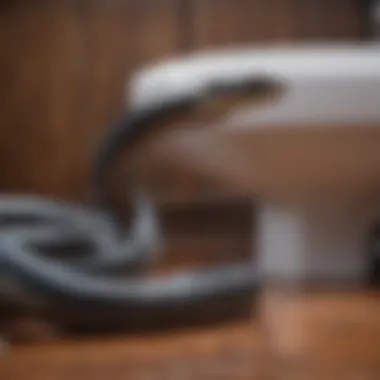
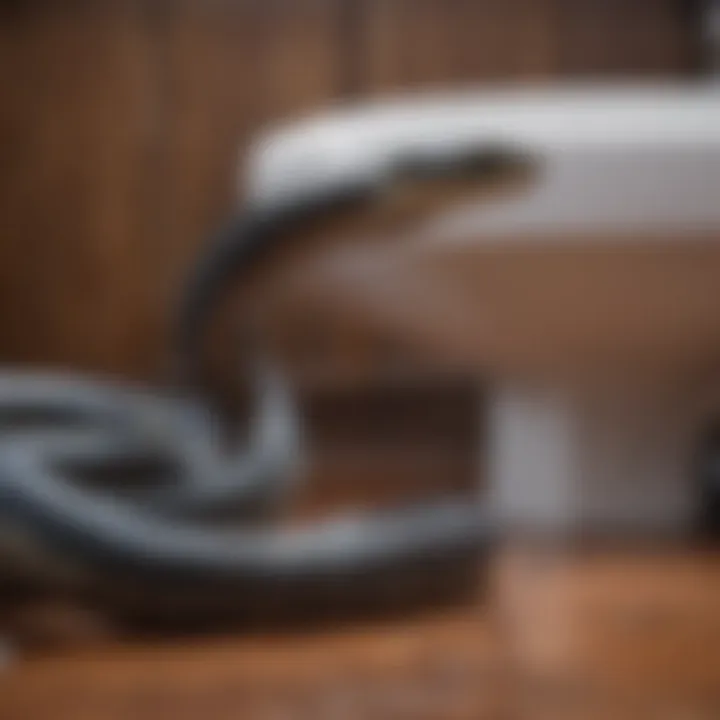
Natural Remedies for Unclogging Toilets
Natural remedies are increasingly valued for their eco-friendliness and effectiveness in addressing common household problems, such as clogged toilets. These remedies often utilize everyday household items that are gentle on plumbing yet effective in dissolving or dislodging blockages. These methods often avoid the harsh chemicals found in some commercial products, making them a safer option for homes with children or pets. Understanding natural remedies is essential for anyone looking to maintain their toilet and plumbing systems effectively while also considering environmental impacts.
Baking Soda and Vinegar
Step-by-step guide
Using baking soda and vinegar is a simple yet effective method for unclogging toilets. This combination works through a chemical reaction that creates carbon dioxide bubbles, which can help break down clogs. To start this process, you should first remove any excess water from the toilet bowl to allow the solution to work more effectively. Next, pour about a cup of baking soda into the toilet bowl, followed by one to two cups of vinegar. Allow the mixture to fizz and sit for about 30 minutes. Then, flush the toilet to see if the clog has cleared.
The key characteristic of this method is the availability of ingredients. Most households already have baking soda and vinegar, making this a very accessible option. It’s important to note that while this method can be effective for light clogs, it may not resolve more stubborn blockages. The ease of use and low cost makes it a beneficial choice for anyone looking for a quick fix to minor issues.
Effectiveness of this method
The effectiveness of using baking soda and vinegar largely depends on the type and severity of the clog. For basic clogs caused by organic matter, this method can be quite effective. The fizzing action created by the reaction breaks down debris, allowing it to disperse more easily.
However, this method has limitations. It may not be suitable for more serious blockages, which may require stronger interventions. Despite this, its popularity stems from its safety and eco-friendliness compared to harsh chemical solutions. It serves as a gentle yet practical option for routine maintenance.
Salt and Hot Water
How this method works
The combination of salt and hot water is another natural remedy worth exploring. Salt acts as a desiccant, meaning it can absorb excess moisture, and when combined with hot water, it helps to break down clogs. To use this method, start by boiling a pot of water. Then, carefully pour a generous amount of salt into the toilet bowl, followed by the hot water. Allow the mixture to sit for several hours or overnight, then flush.
The key feature of this method is its simplicity. This approach requires minimal effort, and often the ingredients are readily available. This method is beneficial for those who want a straightforward approach without needing any special tools. However, excessive use of salt can corrode plumbing over time, so this method should be used sparingly.
Best practices for application
When applying the salt and hot water method, it is crucial to ensure that the water is hot but not boiling, as extremely high temperatures can damage porcelain. The effectiveness of this method increases with time, so allowing it to sit overnight can yield better results. It’s also advisable to follow up with a flush to remove any remaining salt and debris.
Maintenance Tips to Prevent Clogs
Maintaining a functional toilet is essential for any household. Prevention is often more effective than cure. By adhering to routine maintenance tips, homeowners can minimize the likelihood of encountering problematic clogs. These practices are beneficial not just for the immediate functionality of the toilet, but also for prolonging its lifespan. Regular maintenance can save money on plumbing repairs and increase the efficiency of the plumbing system.
Regular Inspection
Conducting regular inspections of your toilet is critical. This involves checking the flush mechanism and the bowl for any leaks or unusual sounds. If you observe constant running water or water pooling around the base, these might indicate an underlying issue. Attention to such signs early on can prevent larger problems in the future. Setting a schedule, such as quarterly inspections, can help in identifying these faults before they escalate.
Proper Waste Disposal
Proper waste disposal is vital in keeping toilets clear of clogs. Toilets are designed to handle human waste and toilet paper only. To maintain a functioning toilet, adhere to the following points:
- Dispose of feminine hygiene products, baby wipes, and similar items in trash bins, not in the toilet.
- Avoid flushing large quantities of toilet paper at once.
- Educate all family members about what can and cannot go down the toilet.
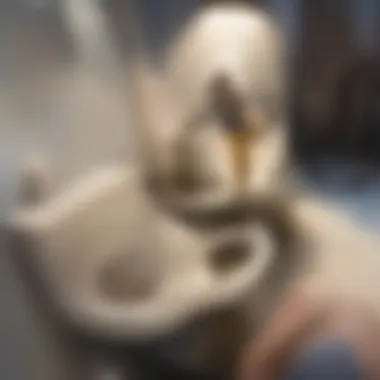
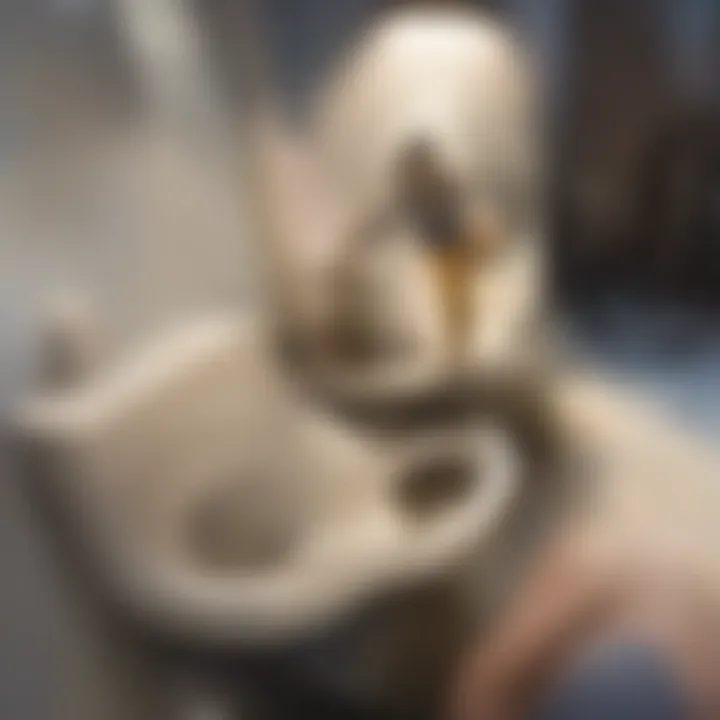
Implementing these practices reduces the risk of blockages significantly. A focused effort on waste disposal will lead to fewer clogs and less hassle on routine cleanings.
Avoiding Flushing Wrong Items
Flushing items that are not meant to go down the toilet creates many issues. Doing so can cause immediate clogs or even long-term damage to plumbing systems. Follow this guideline to prevent flushing wrong items:
- Remember to only flush what is necessary. Use the toilet strictly for its intended purpose.
- Avoid flushing anything made of plastic or non-biodegradable materials.
- Keep a list of toilet-friendly items displayed near the toilet as a reminder.
"Being mindful of what goes into the toilet is a simple yet effective way to prevent many plumbing issues."
By being proactive in avoiding common mistakes, you can maintain a well-functioning toilet. Regular inspections, proper waste disposal, and awareness of suitable flushing practices can all contribute to a smoother toilet experience.
When to Call a Professional
Toilet clogs can often be a simple nuisance. However, there are instances when it is prudent to seek professional help. Understanding when to call a plumber saves time, effort, and potential damage to plumbing systems. Instructing oneself on this aspect is essential for maintaining home functionality.
Identifying Serious Clogs
Not all clogs are equal. Some are minor and can be resolved with basic tools. Others indicate more serious underlying problems. It is crucial to recognize the signs of a severe clog.
Consider these factors:
- Duration: If a clog persists after several attempts to clear it, this may indicate a more serious issue.
- Multiple Fixtures: A clog that affects multiple toilets or drains simultaneously suggests a main line blockage.
- Water Backup: If water backs up into other fixtures, this is a sign of significant plumbing problems.
- Foul Odors: Unpleasant smells emanating from the toilet or sewage lines can point to serious clogs or sewer line issues.
Each of these symptoms warrants professional assessment. Ignoring them can lead to more extensive damage and costly repairs in the long run.
Understanding Plumbing Systems
A solid grasp of plumbing systems is vital when dealing with toilet clogs. Residential plumbing varies significantly in design and complexity. Knowledge about these systems can inform homeowners about when to enlist professional support.
Key considerations include:
- Age of the Plumbing: Older systems may have more issues due to corrosion or wear-and-tear.
- Main Sewer Line: Understanding where your main sewer line is located helps gauge whether a clog is localized or systemic.
- Pipe Materials: Different materials can affect the type of clogs that occur and their resistance to intervention.
- Local Regulations: In some regions, specific codes must be followed during plumbing repairs, necessitating professional assistance.
Recognizing these details makes it easier to identify when the situation surpasses a DIY effort.
A clogged toilet may seem insignificant at first, but leaving it unattended can escalate into a larger issue that requires immediate attention.
Ending
Understanding the process of unclogging toilets is crucial for both homeowners and renters alike. A clogged toilet often leads to inconvenience and can disrupt the daily routine of a household. It can also result in expensive repairs if not addressed in a timely manner. This article has provided valuable insights into various methods and tools available for effectively handling toilet clogs.
Recap of Unclogging Methods
Throughout this guide, we explored several effective solutions for unclogging toilets. Here’s a recap of the key methods discussed:
- Plungers: The traditional plunger is a basic yet powerful tool for dealing with most toilet clogs. It’s essential to choose the right type and apply proper techniques to maximize effectiveness.
- Toilet Augers: For stubborn clogs, a toilet auger can be very helpful. Understanding how they function and selecting the right auger for your needs are important steps to consider.
- Chemical Solutions: Chemicals can quickly break down organic materials but come with risks. It's crucial to follow safety guidelines when using these products to avoid damage to plumbing systems or harm to oneself.
- Natural Remedies: Simple household items like baking soda and vinegar offer a less invasive method to tackle clogs. Methods such as using salt and hot water can also provide relief without the use of harsh chemicals.
- Preventive Maintenance: Regular inspections and proper disposal of waste can prevent many clogs before they occur. Awareness of what should not be flushed is vital to maintaining a fully functional restroom.
Final Words on Toilet Maintenance
By understanding the various ways to unclog a toilet and the importance of maintenance, readers are empowered to take control of their home plumbing needs. for more details, refer to Wikipedia or visit Britannica. As you embark on your journey of toilet maintenance, remember that the key to effective plumbing lies in the details.















